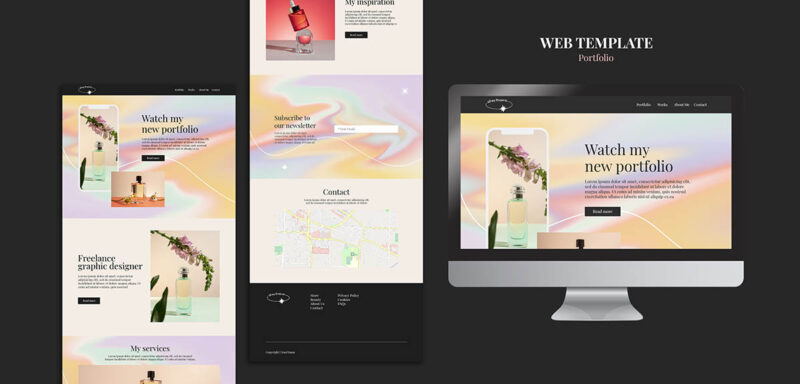
Did you know the average online job ad receives over 250 responses? If you want to land that dream job, you’ll need to outperform 249 people.
On average.
That’s several busloads of people.
It’s old news that the job market is more competitive than ever. Cover letters and resumes are important, sure, but to beat out the opposition, you need to show that you’re cut from a different cloth.
You need the helping hand of an online portfolio website.
The Online Portfolio: Your Digital Business Card
You’ve heard about online portfolios before – but what are they exactly?
There are many website styles and types of portfolios, but they all have one thing in common.
Your online portfolio is your digital business card.
It’s a personal website.
A space you control in your own corner of the internet that serves nobody but you.
You might think a portfolio is something only for artists and other creatives. It’s not. Portfolios are an asset for everyone who has one. Your online portfolio is your chance to put your best foot forward in your industry.
Creating an online portfolio website is hard work. But an optimized, standout portfolio puts everything your clients and employers need to know about you in one place.
Benefits of an Online Portfolio
We’ll run you through the process of creating your portfolio online in just a moment. But first, let’s break down why it’s great to have one.
Benefit #1: Supercharge Your Resume
How many jobs can you list that don’t require a resume? Most require a cover letter on top of that. In other words: everybody has a resume, and it’s probably a cut ‘n’ paste from a quick Google search.
You can spruce it up and give it a unique twist but in all likelihood, it looks the same as a thousand others.
Resumes are boring.
The average recruiter scans a resume for 6 seconds. That sounds harsh, but they’ve got a mountain of them to work through and, with most companies recruiting their talent via the internet, job ads receive huge numbers of applicants.
That’s where your portfolio website comes in.
Put yourself in the shoes of the hiring manager looking over your application. You don’t have a portfolio site, but the next applicant does. That already puts them a full head and shoulders above you at a glance.
You can maximize the potential of your resume until the cows come home. You’ll lose out to the guy or gal who has their own website portfolio. Websites are interactive and visual – and that’s the crux of the portfolio. It’s so much more than words on a page.
Benefit #2: Demonstrate Professionalism
Portfolio sites exude professionalism. While your cover letter might claim experience and achievements, it’s tantamount to word of mouth. You’re playing your own fanfare, and hiring managers know this.
But in an online portfolio website?
A portfolio is a bold first impression. You show your professionalism and capabilities first-hand. Whoever you’re pitching or applying to can see for themselves that you’ve got the experience and aptitude you’re parading about.
Benefit #3: Establish a Brand
To beat a dead horse, resumes all look the same. The same format, the same information, the same smiling headshot.
A digital portfolio, by contrast, allows you to create your brand your way. Your theme, style, layout, and logo all depict who you are and what you’re about.
You’re creating your own, immutable voice in the industry – and that will take you far while allowing you to express your individuality.

How to Create a Killer Portfolio
You know the “why”. If you’re raring to get stuck in but aren’t sure how don’t fret. We’ve got your back.
Let’s dive in and discuss how to create an online portfolio.
Step #1: Create a Website
The first step is to create your professional website. Start by picking a service that will host your portfolio. WordPress is always a great option, but there are others to consider.
If you can afford it, upgrade. Buying a unique domain name comes off as more professional and established.
Although you may be tempted to stuff your portfolio full of pages and content, remember that less is more. Pick a simple, elegant theme and focus on the user experience. Your page should load in a flash and be easy to navigate.
Step #2: Present Key Information
Think of your portfolio as both an extension of your resume and a full-blown alternative to it.
Your “about me” section should be a brief summary of your professional and personal achievements to date. It’s vital to have up-to-date contact info on hand and state your intentions.
If somebody happens across your portfolio by accident, they need to know if you’re actively seeking employment – and how to get in touch if you are.
Step #3: Exhibit Your Best Work
You want to showcase your absolute best work. This is the beating heart of your project portfolio, so hold nothing back. That being said, don’t throw everything and the kitchen sink into it.
Quality matters more than quantity.
Moreover, it’s important to let your work speak for itself. A quick description of each project and what makes it different is enough.
If you work in several niches or have a lot of samples to add, consider breaking your exhibit section into categories. These could be “new” and “old” or separated by niche or theme. Go with what feels best but don’t overthink it.
You can always reshuffle and see what gets better results.
Step #4: Advertise Your Services
Unless you state exactly what you’re offering, your portfolio is costing you opportunities. You’re providing a service. You could be an employer’s next web development wizard or a client’s best photographer to date.
Advertise what you’re offering. If you work on a contract basis, list your rates. If you’re based out of the home office, let employers know. Be comprehensive and list every service and skill that you offer.
People who want to hire you need to know that you can fulfill their needs.
Step #5: Contrast With Other Portfolios
Here’s an insider tip: look at what the best in your field are already doing. Once your portfolio is drafted, polished, and ready to go, spend a few hours looking upward.
Find the best in your field, and gut their portfolios.
Are they doing anything differently? Look at every angle – how many pages do they have? How wordy is their “about me”? How many projects do they showcase?
Does their portfolio pop in a way that yours doesn’t?
Comparing your portfolio with the pros will teach you a lot. Don’t knock it before you’ve tried it.
Tips for Young Professionals
You’ve learned the basics of how to make an online portfolio and you’re ready to get cracking. As a final thought, we’ve curated a handful of ideas for professionals in different spheres.
Artists
As an artist, you want to catch their eyes. Focus on the visuals. Exhibitions and images are the key to a great art portfolio. That being said, it can’t hurt to offer descriptions and your unique insight into your works in written format.
Consider adding a “learn more” section to your pieces that lets your site visitors discover the thought process behind your work samples.
Graphic Designers
Like artists, graphic designers are all about looks. Your portfolio is a work sample itself. Don’t just aim for good or snappy – designer portfolio sites should jump out to any potential lead.
The best graphic designer portfolios will make anybody wish their website looked half as good. While you can use Behance, Portfoliobox, Adobe Portfolio, Crevado, Dribbble, or any other paid and free portfolio builders, designing your own from scratch will really set you apart!
Musicians
As a musician, there’s no better way to showcase your abilities than to let your visitors listen to your music. Your portfolio page will need links to audio and video, whether it’s on Spotify, Soundcloud, YouTube, or elsewhere.
Live clips of you or your ensemble or band playing are great proof that you can perform as well as record. Make sure to include a contact form to allow prospective customers the chance to book a gig with you!
Photographers
Interactive albums of past clients are great to flick through – but consider including your personal scrapbook of winning shots and great photo opportunities.
In addition, including an image or two of your studio is a good way of showing off your professional setup to close the deal.
Web Developers
If you’re a web developer, your portfolio website is your chance to do something a little differently. Develop a site from scratch, use plugins and a portfolio builder, or show off your programming skills to create something new and totally you.
Innovative tech startups are often great sources of design for web developers. But, like a writer writing about how to write well, as a web developer, you’re going to have to make sure your portfolio is solid. From the UX/UI on the home page to the web design you use to show off your web dev skills, show off your past work on a site that is the best portfolio example of your design skills itself.
Writers
As a writer, your portfolio should link to published pieces. Credibility flows from established brands regardless of whether you were paid for what you wrote or not.
Consider beefing up your personal blog section with essays and thought leadership pieces on the niches you write in that offer a unique take. Employers and clients love to see critical thinking on top of solid writing chops. Finally, include your email address to let them reach out!
What Are You Waiting For?
Online portfolio websites are essentially digital business cards.
And, the good thing is, it’s easier than ever before to set one up.
No matter your profession, a writing, technology, or design portfolio site done right will take your career game to another league.
We hope this article helped you learn how to build an online portfolio site of your own, as well as why it’s important to your job application. If you have any questions, let us know in the comments below 🙂 Thanks for reading!











